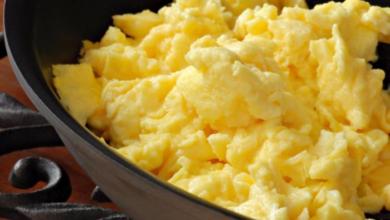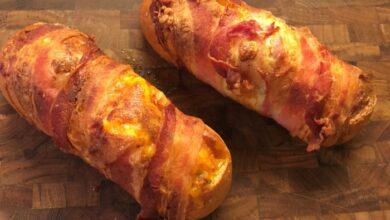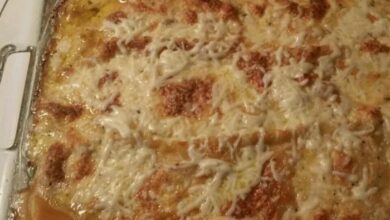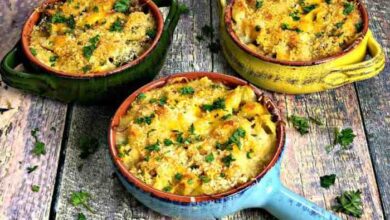
Bacon Cheddar and Spinach Strata: A Savory Brunch Delight
Bacon cheddar and spinach strata is a dish that embodies the essence of comfort food. This savory casserole, reminiscent of a quiche but with a more rustic charm, is a symphony of flavors and textures that tantalizes the taste buds.
The combination of crispy bacon, creamy cheddar cheese, and earthy spinach creates a harmonious balance that is both satisfying and irresistible.
The origins of this dish are shrouded in culinary folklore, but its enduring popularity speaks volumes about its appeal. Whether enjoyed for brunch, a light dinner, or even a hearty breakfast, bacon cheddar and spinach strata is a versatile culinary creation that can be adapted to suit various tastes and dietary preferences.
Bacon Cheddar and Spinach Strata: A Savory Breakfast Delight
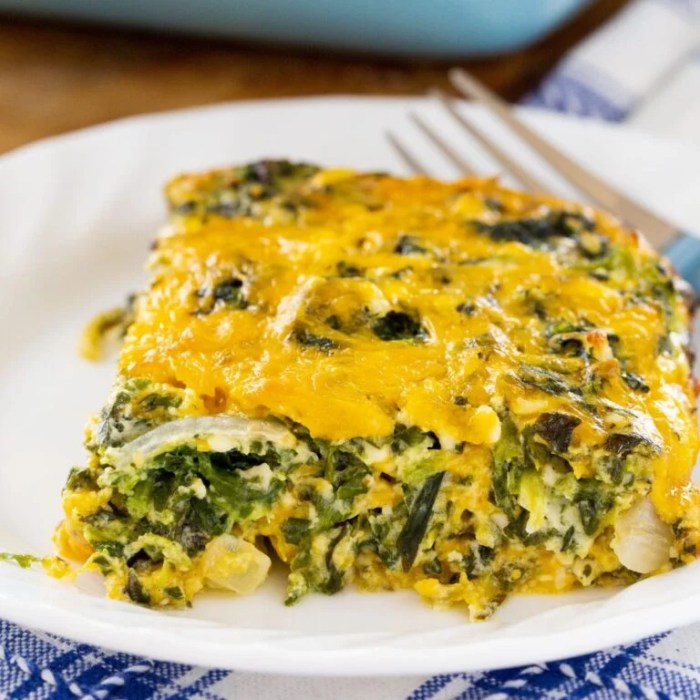
A breakfast casserole that’s both comforting and elegant, bacon cheddar and spinach strata is a dish that’s sure to impress. It’s a hearty and flavorful combination of creamy eggs, crispy bacon, sharp cheddar cheese, and tender spinach, all baked to perfection in a golden-brown crust.
This dish is versatile and can be adapted to suit your preferences. You can easily add other ingredients like mushrooms, onions, or peppers for extra flavor and texture. The strata can also be prepared ahead of time and reheated, making it an ideal choice for busy mornings or weekend brunches.
Ingredients and Preparation
The key to a successful strata lies in the careful layering of ingredients. The base is a mixture of bread cubes, which absorb the custard and create a satisfyingly dense texture. Next comes a generous layer of bacon, adding a salty and smoky flavor.
A sprinkle of shredded cheddar cheese follows, contributing richness and creaminess. Finally, a handful of fresh spinach is added for a touch of freshness and nutritional value. The entire dish is then poured over with a custard made from eggs, milk, and seasonings, and baked until golden brown and set.The preparation process is relatively straightforward.
The bread is cubed and toasted to ensure it absorbs the custard without becoming soggy. The bacon is cooked until crispy, and the spinach is wilted. The custard is then prepared and poured over the layered ingredients. The strata is then baked in a preheated oven until set.
Ingredients
A traditional bacon cheddar and spinach strata recipe relies on a harmonious blend of ingredients, each playing a crucial role in crafting its savory and satisfying flavor profile. The ingredients can be categorized into three primary groups: the base, the filling, and the binder.
Base
The base of the strata provides the foundation for the dish, creating a structure that holds the other ingredients together. It typically consists of:
- Bread:The bread serves as the base, absorbing the custard and providing a hearty texture. It can be stale bread, like crusty bread or French bread, or even a combination of different types. The staling process allows the bread to absorb the custard better, preventing the strata from becoming soggy.
- Eggs:Eggs are the primary binder, adding structure and richness to the strata. They also contribute to the dish’s protein content.
- Milk:Milk is another essential binder, adding moisture and creaminess to the strata. It helps create a smooth and velvety texture, blending harmoniously with the other ingredients.
- Cheese:A flavorful cheese, such as cheddar, adds a rich and savory note to the strata. It melts beautifully, creating a gooey and satisfying texture.
Filling
The filling is the heart of the strata, adding flavor and texture. Common ingredients include:
- Bacon:Crispy bacon adds a salty and smoky depth of flavor to the strata. Its crunch provides a textural contrast to the soft bread and creamy custard.
- Spinach:Spinach provides a fresh, earthy flavor and adds a healthy dose of vitamins and minerals. It also adds a vibrant green color to the dish.
- Onions:Onions add a sweet and savory element to the strata. They can be sautéed before adding them to the dish, bringing out their natural sweetness and creating a caramelized flavor.
- Garlic:Garlic adds a pungent and aromatic note to the strata, enhancing the overall flavor profile.
Variations and Substitutions
While the traditional bacon cheddar and spinach strata recipe offers a classic and delicious combination, there’s room for variations and substitutions to personalize the dish.
- Bread:You can experiment with different types of bread, such as sourdough, challah, or even croissants. However, ensure the bread is stale or toasted for optimal absorption.
- Cheese:Instead of cheddar, you can use other cheeses like Monterey Jack, Gruyere, or even a blend of cheeses for a more complex flavor profile.
- Filling:You can substitute the spinach with other leafy greens, like kale or arugula. Additionally, you can incorporate different vegetables, such as mushrooms, bell peppers, or diced tomatoes, to add variety.
- Protein:Instead of bacon, you can use ham, sausage, or even shredded chicken or turkey for a different flavor and texture.
- Seasonings:You can add other seasonings, such as herbs like thyme, rosemary, or oregano, to enhance the flavor profile of the strata.
Preparation
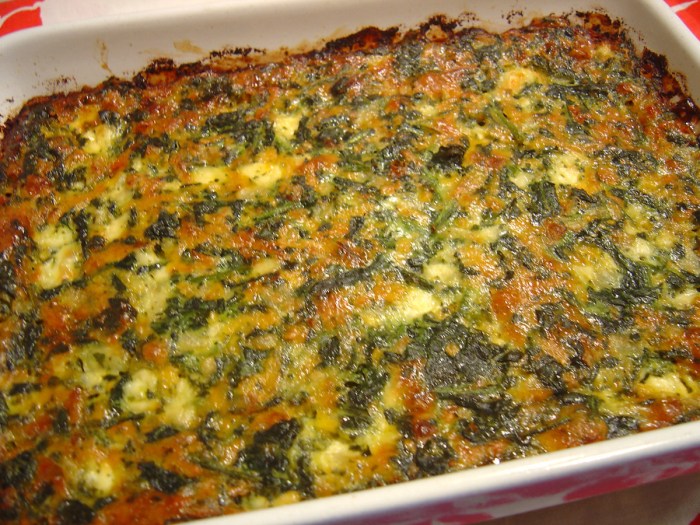
The preparation process for this strata is straightforward and involves a few simple steps. The key is to layer the ingredients in the right order, ensuring each element gets a chance to shine.
Preparing the Ingredients
The first step involves prepping the ingredients, which sets the stage for the strata’s deliciousness.
- Start by preheating the oven to 350 degrees Fahrenheit (175 degrees Celsius). This ensures the strata cooks evenly and achieves the perfect golden-brown crust.
- Next, cook the bacon. This step is crucial as it infuses the strata with a smoky, savory flavor. You can cook it in a skillet over medium heat until it reaches your desired crispiness. Remember to drain any excess grease.
- While the bacon is cooking, you can start preparing the spinach. This step involves sautéing the spinach in a large skillet with a little olive oil until it wilts, ensuring it’s tender but not mushy.
- Now, it’s time to grate the cheddar cheese. You can use a cheese grater or a food processor to get the desired texture. The grated cheese will melt beautifully throughout the strata, adding a creamy and cheesy flavor.
- Finally, whisk together the eggs, milk, salt, and pepper. This mixture will act as the binding agent, ensuring the strata holds together and cooks evenly.
Assembling the Strata
The next step is assembling the strata, where you layer the ingredients to create a symphony of flavors.
- Start by greasing a 9×13 inch baking dish. This prevents the strata from sticking and ensures it releases easily once baked.
- Now, layer half of the cooked bacon in the bottom of the baking dish. This creates a base of smoky flavor that permeates the entire strata.
- Next, sprinkle half of the sautéed spinach over the bacon. This adds a fresh, earthy flavor and a vibrant green hue.
- Follow this with half of the grated cheddar cheese. This layer adds a creamy, cheesy richness that complements the other flavors.
- Now, pour half of the egg mixture over the cheese. This will bind the ingredients together and create a moist, custardy texture.
- Repeat the layering process with the remaining bacon, spinach, cheese, and egg mixture. This ensures that each element is evenly distributed throughout the strata.
Baking the Strata
The final step involves baking the strata until it’s golden brown and set, allowing the flavors to meld together.
- Bake the strata in the preheated oven for 45-50 minutes, or until a knife inserted into the center comes out clean. This ensures the strata is cooked through and the egg mixture is set.
- Let the strata cool for 10 minutes before slicing and serving. This allows the strata to set and prevents it from falling apart when cut.
Cooking Techniques
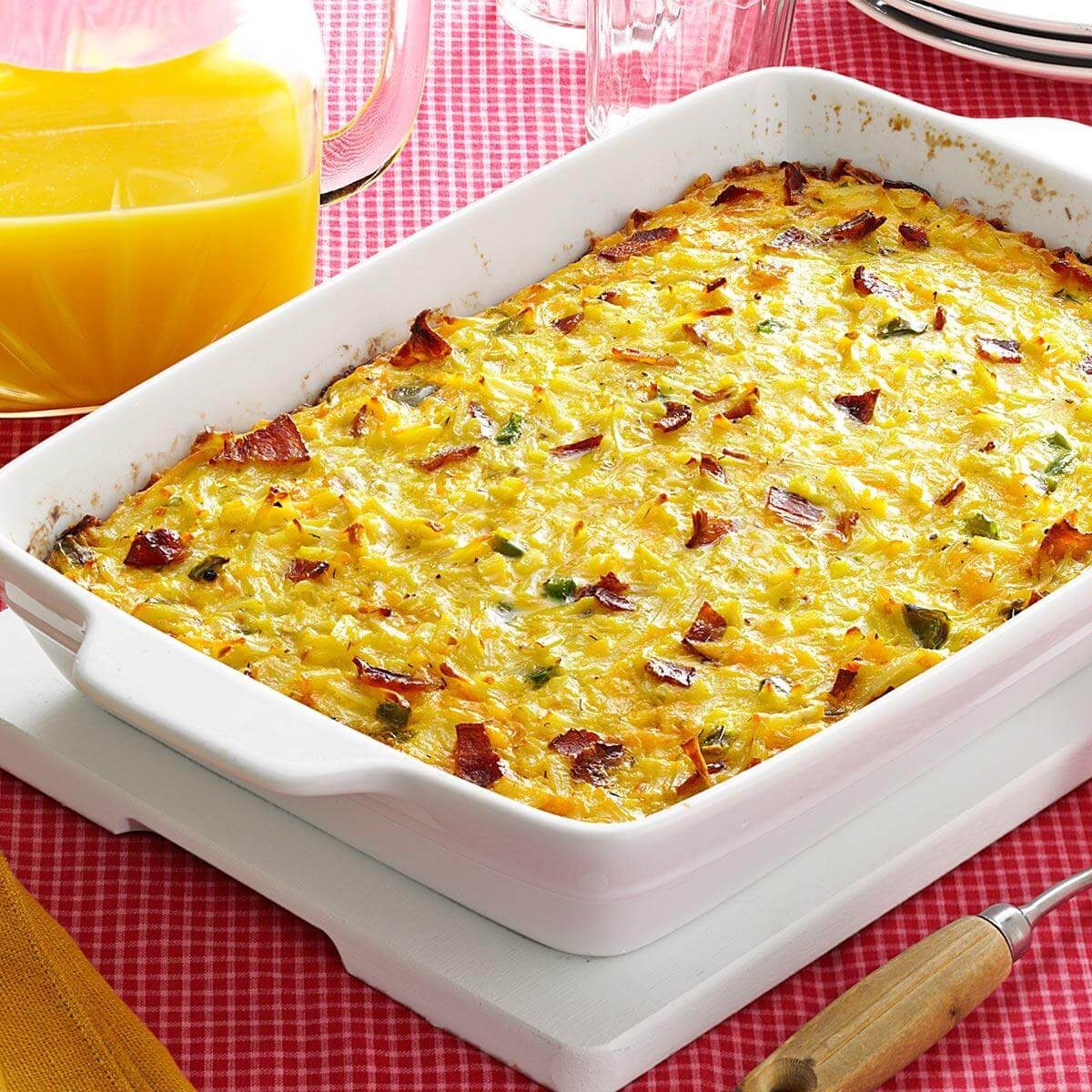
Cooking a bacon cheddar and spinach strata is a straightforward process, but the method you choose can significantly impact the final result. While the basic principle involves layering ingredients and baking, there are several variations that can be employed, each with its own advantages and disadvantages.
Oven Baking
Oven baking is the most traditional and widely used method for cooking strata. It involves assembling the strata in a baking dish, covering it with foil, and baking it in a preheated oven until it is set and golden brown.
- Advantages:
- Even Cooking:The oven provides consistent heat distribution, ensuring that the strata cooks evenly throughout.
- Moistness:Covering the strata with foil during the initial baking time helps to retain moisture and prevent the ingredients from drying out.
- Simplicity:Oven baking is a simple and straightforward method that requires minimal supervision.
- Disadvantages:
- Longer Cooking Time:Oven baking typically takes longer than other methods, requiring about 45-60 minutes for a standard strata.
- Potential for Over-Baking:It’s crucial to monitor the strata closely to prevent over-baking, which can lead to a dry and crumbly texture.
- Optimal Cooking Time and Temperature:
- Bake at 350°F (175°C) for 45-60 minutes, or until the strata is set and golden brown. The exact cooking time will vary depending on the size and depth of the baking dish and the amount of ingredients used.
Slow Cooker
Slow cooking is an excellent option for those who prefer a hands-off approach to cooking. It involves assembling the strata in a slow cooker and cooking it on low heat for several hours.
Bacon cheddar and spinach strata is a comforting dish that’s perfect for a weekend brunch or a hearty weeknight dinner. The richness of the cheese and bacon pairs beautifully with the earthy spinach, creating a flavor explosion in every bite.
If you’re looking for a lighter side dish to accompany your strata, try these grilled asparagus steak bundles. The smoky char of the asparagus and the juicy steak create a delightful contrast to the creamy strata.
- Advantages:
- Convenience:Slow cooking allows you to prepare the strata in the morning and have it ready for breakfast or brunch without any additional effort.
- Tenderness:The long cooking time in a slow cooker results in a tender and flavorful strata.
- Moisture Retention:The slow cooker environment helps to retain moisture, preventing the strata from drying out.
- Disadvantages:
- Longer Cooking Time:Slow cooking typically takes several hours, making it less suitable for last-minute meals.
- Limited Browning:The slow cooker environment doesn’t produce the same browning effect as oven baking.
- Optimal Cooking Time and Temperature:
- Cook on low heat for 4-6 hours, or until the strata is set and heated through. The exact cooking time will vary depending on the size of the slow cooker and the amount of ingredients used.
Skillet
Cooking strata in a skillet is a quick and easy option for smaller portions. It involves assembling the strata in a skillet and cooking it over medium heat until it is set and golden brown.
- Advantages:
- Quick Cooking Time:Skillet cooking is significantly faster than oven baking or slow cooking, typically taking around 20-30 minutes.
- Browning:The direct heat from the skillet promotes browning, resulting in a crispy and flavorful crust.
- Versatility:Skillet cooking allows you to easily adjust the amount of strata you are making, making it perfect for smaller meals or individual servings.
- Disadvantages:
- Limited Capacity:Skillet cooking is limited to smaller portions due to the size of the skillet.
- Potential for Over-Cooking:It’s essential to monitor the strata closely to prevent over-cooking, which can lead to a dry and burnt texture.
- Optimal Cooking Time and Temperature:
- Cook over medium heat for 20-30 minutes, or until the strata is set and golden brown. The exact cooking time will vary depending on the size of the skillet and the amount of ingredients used.
Variations and Adaptations
The beauty of this strata lies in its adaptability. You can easily tweak the recipe to suit your taste buds and dietary needs, making it a versatile dish for any occasion. Let’s explore some popular variations and adaptations to enhance your strata experience.
Bacon cheddar and spinach strata is a dish that’s perfect for a weekend brunch, offering a savory and satisfying meal. The creamy base, infused with the richness of cheese and the earthy flavor of spinach, is a wonderful complement to the crispy bacon.
For a truly decadent touch, consider serving it alongside a side of nanis mashed potato casserole , which adds a touch of comfort and warmth to the meal. The combination of these two dishes creates a truly satisfying and memorable brunch experience.
Ingredient Substitutions
This strata is a blank canvas for your culinary creativity. Feel free to swap out ingredients for alternatives that align with your preferences or dietary restrictions.
- Cheese:Experiment with different cheeses, such as Monterey Jack, Gruyere, or even a blend of cheddar and Swiss.
- Greens:While spinach is a classic choice, feel free to use other leafy greens like kale, chard, or even arugula.
- Meat:If you prefer a different protein, you can substitute the bacon with sausage, ham, or even ground beef.
- Vegetables:Add additional vegetables for a more flavorful and nutritious strata. Mushrooms, diced bell peppers, or chopped onions are excellent additions.
Dietary Adaptations
This recipe can be easily modified to accommodate various dietary needs.
- Vegetarian:Omit the bacon and replace it with a vegetarian alternative like crumbled tempeh or plant-based sausage.
- Dairy-Free:Use a dairy-free cheese alternative, such as vegan cheddar or cashew cheese, and substitute milk with a non-dairy milk like almond or soy milk.
- Gluten-Free:Use gluten-free bread or a combination of gluten-free breadcrumbs and shredded vegetables to create a gluten-free strata.
Serving Suggestions
A bacon cheddar and spinach strata is a versatile dish that can be served for a variety of occasions, from a leisurely weekend brunch to a more formal gathering. Its rich flavors and hearty texture make it a satisfying and crowd-pleasing option.
Serving Suggestions, Bacon cheddar and spinach strata
The strata can be served warm or at room temperature. It can be cut into squares or wedges, and served on individual plates or in a large platter. Here are some creative serving suggestions:
| Occasion | Serving Style | Accompaniments | Beverages |
|---|---|---|---|
| Weekend Brunch | Cut into squares, served on individual plates | Fresh fruit salad, yogurt parfait, a side of roasted potatoes | Mimosas, orange juice, coffee, tea |
| Formal Gathering | Cut into wedges, served on a large platter | A green salad with vinaigrette dressing, a selection of artisan breads | Champagne, white wine, sparkling water |
| Potluck | Cut into squares, served in a casserole dish | A variety of dips, spreads, and salads | Lemonade, iced tea, water |
| Casual Dinner | Cut into wedges, served with a side of roasted vegetables | A simple green salad, a glass of red wine | Red wine, beer, water |
Nutritional Information
Bacon cheddar and spinach strata is a hearty and flavorful breakfast dish, but its nutritional profile can vary depending on the ingredients and portion size. Here’s a breakdown of the nutritional content and some tips for making healthier variations.
Nutritional Breakdown
The nutritional content of a typical serving of bacon cheddar and spinach strata can vary depending on the specific recipe and ingredients used. However, a general approximation of the nutritional values per serving is as follows:
- Calories: 350-450
- Fat: 25-35 grams
- Saturated Fat: 10-15 grams
- Cholesterol: 80-100 milligrams
- Sodium: 600-800 milligrams
- Carbohydrates: 20-30 grams
- Fiber: 3-5 grams
- Sugar: 2-4 grams
- Protein: 15-20 grams
Potential Health Benefits and Drawbacks
Bacon cheddar and spinach strata is a source of protein, fiber, and some vitamins and minerals. However, it is also high in saturated fat, cholesterol, and sodium, which can contribute to heart disease and other health problems if consumed regularly in large quantities.
Bacon, cheddar, and spinach strata is a hearty and comforting dish that’s perfect for a weekend brunch. It’s also a great way to use up leftover bread. If you’re looking for a lighter option, you might try something like spanish garlic shrimp gambas al ajillo , a delicious and flavorful dish that’s sure to impress.
But if you’re craving something rich and satisfying, strata is the way to go.
Tips for Healthier Variations
- Use leaner bacon or turkey bacon to reduce saturated fat and calories.
- Reduce the amount of cheese used or substitute it with lower-fat cheese varieties.
- Add more vegetables, such as mushrooms, onions, or peppers, for added fiber and nutrients.
- Use whole-wheat bread for a boost of fiber.
- Bake the strata in a nonstick pan to reduce the need for added oil.
Reducing Calorie Intake
To reduce the calorie intake of bacon cheddar and spinach strata, consider these tips:
- Use smaller portions.
- Skip the bacon or use a reduced-fat alternative.
- Reduce the amount of cheese used.
- Serve the strata with a side of fresh fruit or a light salad instead of a heavy side dish.
Historical Context: Bacon Cheddar And Spinach Strata
While the precise origins of the bacon cheddar and spinach strata remain shrouded in culinary history, its roots likely lie in the evolution of traditional breakfast dishes across various cultures. The strata, with its layered components, reflects a culinary technique that has been practiced for centuries, with influences from both European and American cuisines.
Cultural Influences
The strata’s origins can be traced back to various cultural influences:* European Influences:The strata’s layered structure and use of cheese and bread are reminiscent of European dishes like French quiche and Italian frittata. These dishes, often incorporating eggs and cheese, have long been staples of European breakfast and brunch tables.
American Influences
The addition of bacon and spinach to the strata reflects the American love for hearty and savory breakfast options. The dish’s popularity in the United States likely arose during the 20th century, as breakfast trends shifted towards more substantial and protein-rich meals.
Notable Historical Figures or Events
While no specific historical figures or events are directly associated with the creation of the bacon cheddar and spinach strata, the dish’s evolution is intertwined with the broader history of breakfast and brunch culture in both Europe and America. The strata’s popularity has likely been fueled by the growing emphasis on convenient and satisfying breakfast options, particularly in modern times.
Cultural Significance
While the bacon cheddar and spinach strata might not have a rich, historical tradition like some classic dishes, it’s a testament to the adaptability and creativity of modern cuisine. Its popularity stems from its convenience, versatility, and ability to cater to diverse palates.
Popularity and Place in Culinary Traditions
The bacon cheddar and spinach strata’s popularity is rooted in its ability to bridge the gap between traditional breakfast fare and modern culinary trends. The dish offers a hearty and satisfying meal, combining familiar flavors with a touch of sophistication.
Its versatility allows for customization, making it adaptable to various dietary needs and preferences. This adaptability is particularly appealing in multicultural societies where diverse culinary influences converge.
Anecdotes and Stories
While the bacon cheddar and spinach strata may not have a specific origin story or cultural folklore, it has become a staple in many modern households. It’s often featured in brunch gatherings, potlucks, and even as a convenient weeknight dinner option.
The dish’s simplicity and ease of preparation have made it a popular choice for busy families and individuals looking for a satisfying and flavorful meal.

